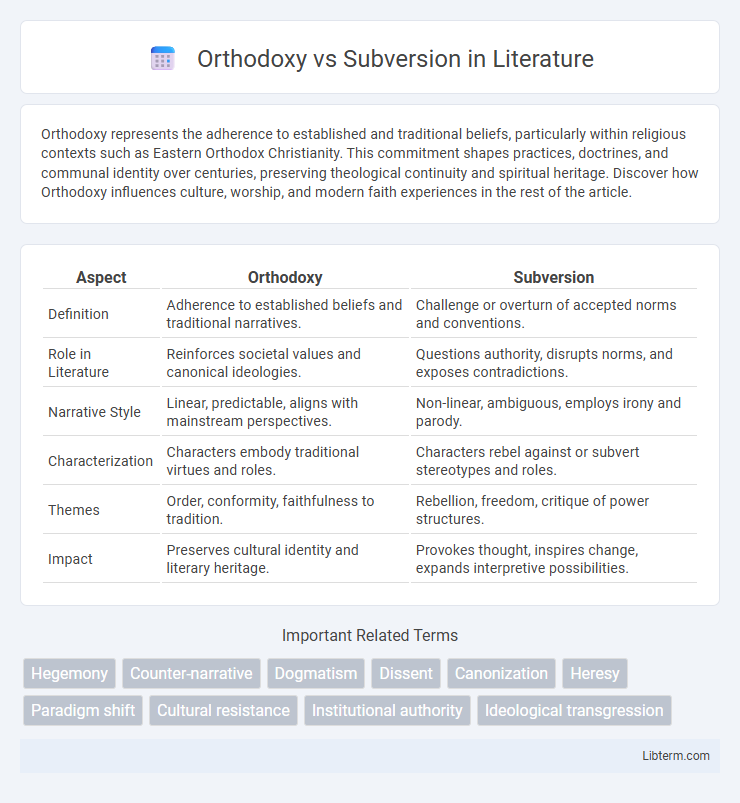Orthodoxy represents the adherence to established and traditional beliefs, particularly within religious contexts such as Eastern Orthodox Christianity. This commitment shapes practices, doctrines, and communal identity over centuries, preserving theological continuity and spiritual heritage. Discover how Orthodoxy influences culture, worship, and modern faith experiences in the rest of the article.
Table of Comparison
| Aspect | Orthodoxy | Subversion |
|---|---|---|
| Definition | Adherence to established beliefs and traditional narratives. | Challenge or overturn of accepted norms and conventions. |
| Role in Literature | Reinforces societal values and canonical ideologies. | Questions authority, disrupts norms, and exposes contradictions. |
| Narrative Style | Linear, predictable, aligns with mainstream perspectives. | Non-linear, ambiguous, employs irony and parody. |
| Characterization | Characters embody traditional virtues and roles. | Characters rebel against or subvert stereotypes and roles. |
| Themes | Order, conformity, faithfulness to tradition. | Rebellion, freedom, critique of power structures. |
| Impact | Preserves cultural identity and literary heritage. | Provokes thought, inspires change, expands interpretive possibilities. |
Defining Orthodoxy and Subversion
Orthodoxy refers to the adherence to established and traditional beliefs or practices within a particular ideology, religion, or cultural system, emphasizing conformity and preservation of the accepted norms. Subversion involves the deliberate challenge or undermining of these established doctrines, often seeking to disrupt or transform the existing power structures and societal conventions. The dynamic between orthodoxy and subversion highlights the tension between maintaining stability and promoting change within any social or ideological framework.
Historical Contexts of Orthodoxy
Orthodoxy historically represents established beliefs and practices maintained by dominant religious or political institutions, often solidified through councils and creeds in Christianity, particularly post-Nicene and Chalcedonian developments. It functions as a framework for social and ideological order, resisting challenges posed by subversive movements that question or undermine established authority, such as early heresies or revolutionary sects. The tension between orthodoxy and subversion reflects broader societal dynamics where maintaining tradition conflicts with innovative or dissenting perspectives throughout history.
The Roots of Subversive Thought
The roots of subversive thought trace back to challenges against established orthodoxies, where questioning traditional doctrines seeds alternative ideologies. Historical movements like the Enlightenment and various revolutionary periods reveal how subversion emerges from intellectual discontent and social disparities. These origins highlight a dynamic interplay between authority and resistance, fueling ongoing debates in philosophy, politics, and culture.
Orthodoxy in Modern Institutions
Orthodoxy in modern institutions enforces adherence to established doctrines, preserving organizational stability and continuity through standardized practices and traditional values. This rigid alignment often limits innovation by prioritizing conformity over adaptation, reinforcing hierarchical control and institutional authority. Despite challenges, orthodoxy ensures predictability and coherence within complex social structures, maintaining legitimacy and collective identity.
Subversion as a Catalyst for Change
Subversion acts as a catalyst for change by challenging established orthodoxies and disrupting conventional power structures. It fuels innovation and social progress through the deliberate questioning of norms and the introduction of alternative perspectives. Subversive actions often expose systemic flaws, paving the way for transformative reforms and cultural evolution.
Cultural Expressions of Orthodoxy
Cultural expressions of orthodoxy often manifest through preserved rituals, traditional art forms, and linguistic continuity that reinforce a community's core beliefs and values. These expressions serve as tangible symbols of collective identity, ensuring stability and resistance to subversive influences that challenge established norms. The persistence of orthodox cultural practices anchors societies by promoting cohesion and continuity amid changing social landscapes.
Art and Literature: Orthodoxy versus Subversion
Art and literature often serve as battlegrounds between orthodoxy and subversion, where traditional norms and established cultural narratives face challenges through innovative or dissenting expressions. Orthodox works typically reinforce societal values and canonical aesthetics, while subversive creations disrupt conventional perspectives by questioning authority, highlighting marginalized voices, and experimenting with form and content. This dynamic interplay shapes cultural evolution by balancing preservation of heritage with transformative critique.
The Dynamics of Power and Dissent
Orthodoxy maintains established power structures by enforcing conformity and suppressing dissent through institutional mechanisms. Subversion challenges these power dynamics by fostering alternative narratives and mobilizing marginalized voices to undermine dominant ideologies. The ongoing tension between orthodoxy and subversion shapes social discourse, influencing political control and cultural transformation.
Orthodoxy, Subversion, and Social Progress
Orthodoxy often represents adherence to established beliefs and traditions that provide social stability and continuity, while subversion challenges these norms, driving societal change and innovation. Social progress emerges from the dynamic interplay between orthodoxy's preservation of cultural values and subversion's push for reform and new ideas. Historical movements demonstrate that balancing orthodox principles with subversive actions fosters inclusive development and transformative growth.
Balancing Tradition and Innovation
Orthodoxy emphasizes preserving established beliefs and practices, ensuring continuity and stability within cultural or religious frameworks. Subversion challenges these norms by introducing innovative ideas and critical perspectives that foster progress and reform. Balancing tradition and innovation requires integrating time-honored values with adaptive strategies to maintain relevance while respecting foundational principles.
Orthodoxy Infographic

 libterm.com
libterm.com